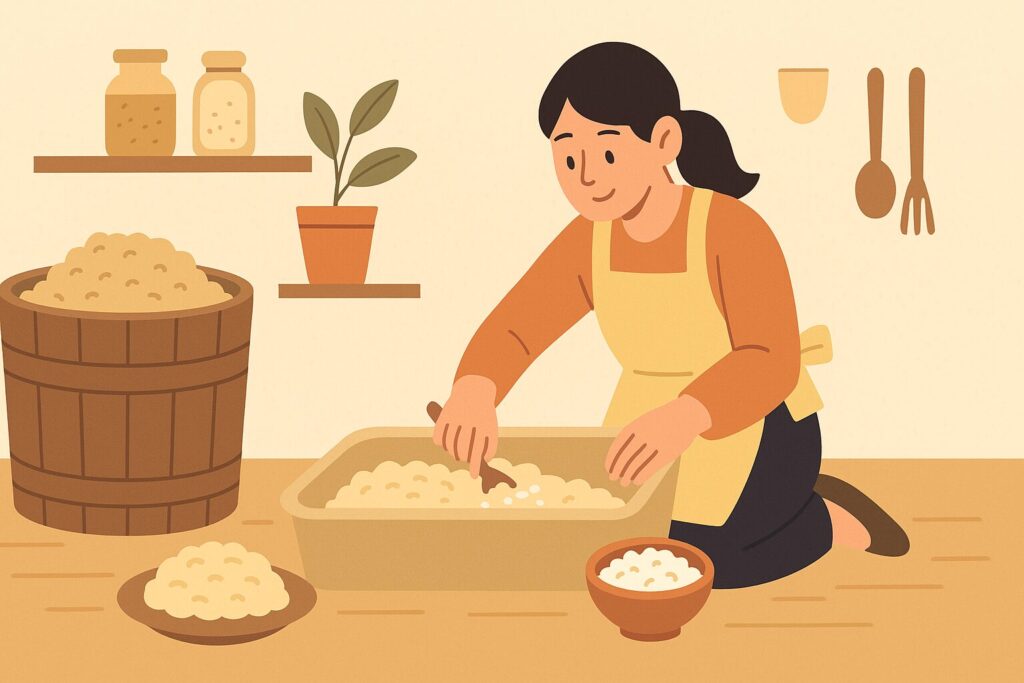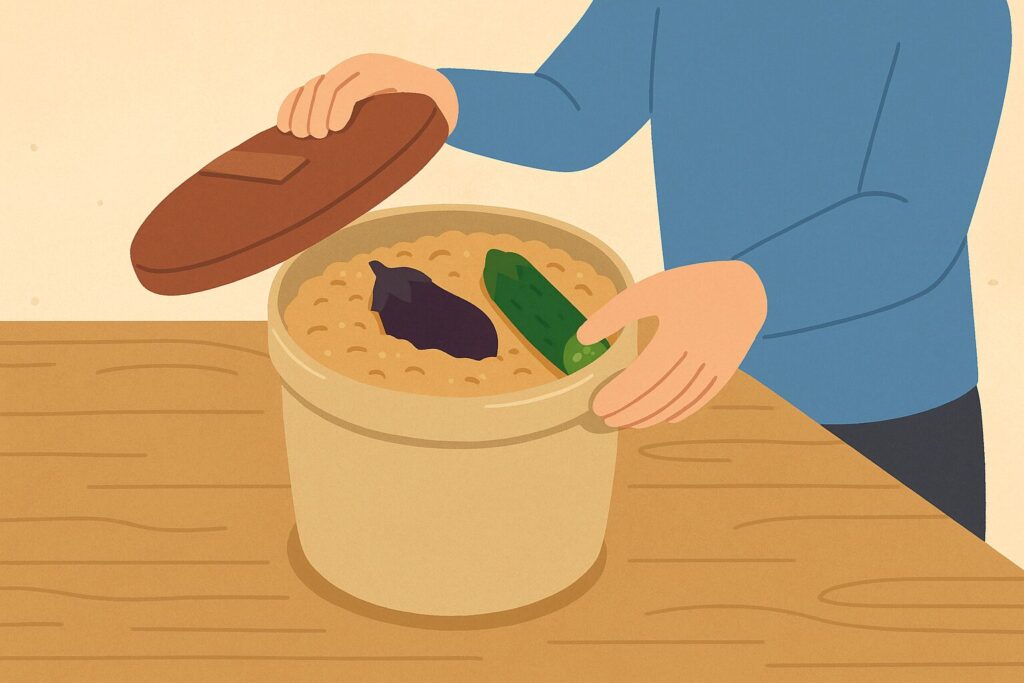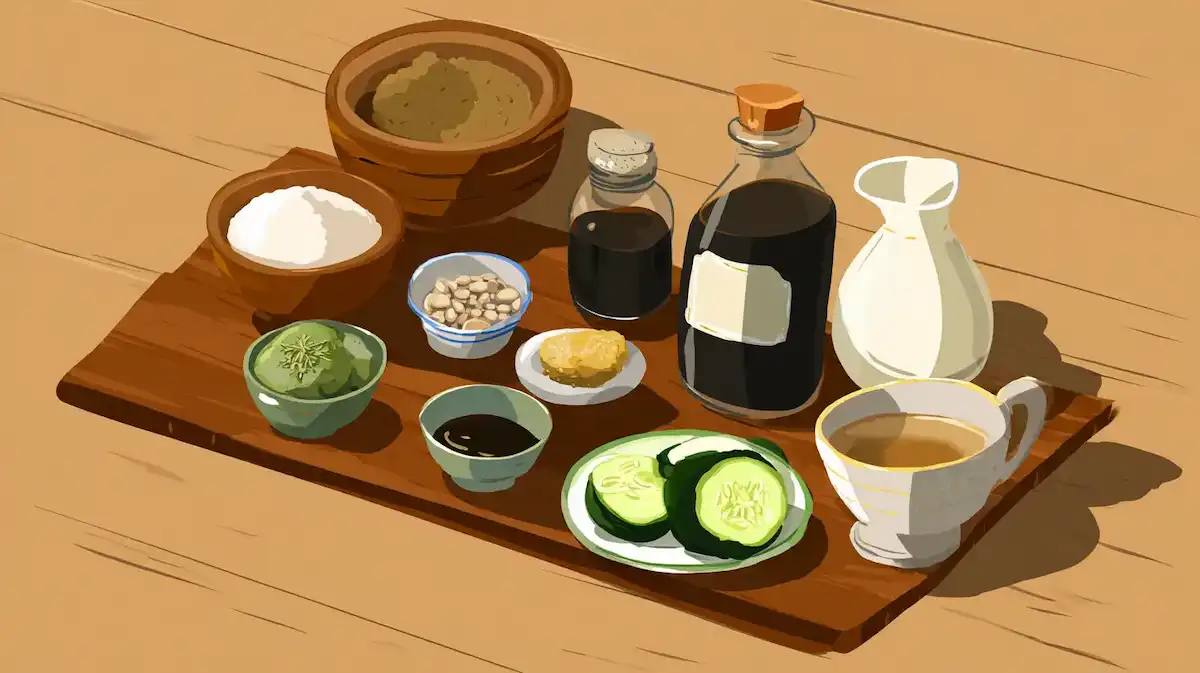日本の発酵食品を英語で説明・紹介するための基本情報と、英会話に役立つ表現をシンプルでわかりやすい英語で紹介します。
英会話ダイアローグ・概要・10の質問を通して、日本の発酵食品に関する英語表現を学びます。
英語
英会話ダイアローグを読む前に知っておくと良い前提知識と情報です。
- 発酵食品とは
- 微生物(麹や酵母など)の働きで、原料が分解されてうまみや栄養、保存性が高まった食品
- 日本は湿度が高く、発酵食品が古くから発達
- 日本の主な発酵食品
- 味噌:大豆や米、麹を発酵させた調味料、味噌汁に使う
- 醤油:大豆と小麦を麹菌で発酵させた液体の調味料
- 納豆:大豆を納豆菌で発酵させた食品。ネバネバした食感
- ぬか漬け:米ぬかに野菜を漬けて乳酸発酵させた漬物
- 甘酒:米麹や酒粕から作る甘い発酵飲料
- かつおぶし:カツオを乾燥・発酵させて作る削り節
- 発酵食品の特徴と魅力
- うまみやコク、独特の香りが生まれる
- 長期間保存できる
- 腸内環境を整えたり、栄養価がアップする
- 日本の伝統や文化と深く結びついている
- 最近の発酵食品ブーム
- 健康志向の高まりや海外での和食人気で、日本の発酵食品は世界でも注目
- 家庭で手作りにチャレンジする人も増えている
2人が日本の発酵食品について話しています。
味噌や甘酒、納豆、ぬか漬けなど、日本の発酵食品の種類や特徴、魅力や人気、家庭での手作り体験などを話題にしています。
会話 / dialogue

Hey Key, have you ever thought about how many Japanese foods are actually fermented? I recently got really interested in them.

Yeah, I’ve noticed that too. Fermented foods are everywhere in Japan—like miso, soy sauce, and even natto. What made you interested?

I tried homemade amazake at a friend’s house, and it was surprisingly delicious. It made me want to learn more about Japanese fermented foods.

That’s great! Amazake is a classic. Did you know there are two types? One is made from rice and koji, and the other uses sake lees.

Really? I didn’t realize that. I think what I tried was the rice and koji version—no alcohol at all, just naturally sweet.

Yeah, that one is popular, especially for kids or people who don’t drink alcohol. Fermentation gives it that special sweetness.

It’s fascinating how fermentation changes food. Why do you think fermented foods are so important in Japanese cuisine?

Well, for one thing, they add a lot of umami and depth to dishes. Miso and soy sauce are the base for so many Japanese flavors.

And they last a long time too, right? Before refrigerators, people really depended on fermentation for food storage.

Exactly. Fermentation made it possible to keep food safe for months. Plus, it improves nutrition—like adding vitamins and making food easier to digest.

That’s probably why Japanese fermented foods are getting popular around the world now. People are really into health and gut-friendly foods.

Definitely. Even overseas, you can find miso, soy sauce, and sometimes even natto in supermarkets. The health benefits are a big selling point.

By the way, what exactly is koji? I see it mentioned a lot, but I don’t really know what it is.

Koji is a type of mold that grows on rice, barley, or soybeans. It’s used to start the fermentation process in many foods—like miso, soy sauce, and sake.

So it’s kind of the secret behind Japanese fermented foods! Are there any other unique fermented foods I should try?

You should try nukazuke—that’s pickles made with rice bran. And katsuobushi, which is dried, fermented bonito flakes, used for making dashi soup stock.

I’ve seen katsuobushi at restaurants—those flakes that move on top of hot food. I didn’t know it was fermented.

Yeah, it’s a very traditional food. Actually, there are many local specialties too, like different types of pickles and even fermented fish products.

Have you ever tried making fermented foods at home? I’m thinking about making miso or amazake myself.

I’ve made nukazuke at home, and it’s fun to see how the flavor changes over time. Making miso or amazake is definitely doable, and you can control the taste.

That sounds exciting. I’d love to try making something myself. I think understanding fermentation is also understanding Japanese culture.

I agree. Fermented foods really connect people to Japanese tradition and history. It’s amazing how old techniques are still so important today.

It’s true. I feel like Japanese fermented foods are special because they’re healthy, tasty, and full of culture.

Absolutely. Next time, let’s visit a shop or maybe join a workshop about making miso or amazake together!
概要 / Overview
「日本の発酵食品」について、理解を深めるための「英語での概要」です。
日本の発酵食品

What Are Japanese Fermented Foods?
Japanese fermented foods are special foods made by using small living things called microorganisms. These include mold (like koji), yeast, and bacteria. The microorganisms change the original food, making it tastier, healthier, and easier to keep. Fermentation is an old technique in Japan, and many traditional Japanese foods are made this way.
Main Types of Fermented Foods
There are many famous Japanese fermented foods. Miso is a paste made from soybeans, rice, and salt. It is often used in miso soup. Soy sauce is a salty liquid used as a seasoning in many dishes. Natto is sticky, strong-smelling fermented soybeans, usually eaten with rice. Amazake is a sweet drink made from rice and koji mold. Nukazuke are pickles made with rice bran. Katsuobushi is dried, fermented bonito fish, often used to make soup stock.
Health Benefits and Popularity
Japanese fermented foods are very healthy. They have good bacteria, vitamins, and more protein. These foods help keep your stomach healthy and can make food easier to digest. Because of these benefits, Japanese fermented foods are becoming popular not only in Japan but also in other countries. You can now find miso, soy sauce, and sometimes natto in supermarkets all over the world.
Tradition and Culture
Fermented foods are an important part of Japanese culture. People have enjoyed these foods for hundreds of years. Making and eating fermented foods connects Japanese people to their traditions. Today, more people even try to make miso or pickles at home. Japanese fermented foods are tasty, healthy, and full of tradition.
10の質問 / 10 questions
「日本の発酵食品」について、理解を深めるための「英語での10の質問」です。
1: What are Japanese fermented foods?
Japanese fermented foods are foods made by using microorganisms, like mold, yeast, or bacteria. These foods have a strong flavor and are good for health.
2: What are some examples of Japanese fermented foods?
Some common examples are miso, soy sauce, natto, pickles, amazake, and katsuobushi.
3: What is miso?
Miso is a paste made from soybeans, rice or barley, and salt. It is often used in miso soup.
4: What is natto?
Natto is fermented soybeans with a sticky texture and a strong smell. People usually eat it with rice.
5: Why are Japanese fermented foods healthy?
They have good bacteria, vitamins, and more protein. They help the stomach and make food easier to digest.
6: What is amazake?
Amazake is a sweet Japanese drink made from rice and koji mold. It is usually non-alcoholic.
7: What is koji?
Koji is a type of mold that helps start the fermentation in foods like miso, soy sauce, and sake.
8: Are Japanese fermented foods popular in other countries?
Yes, foods like miso and soy sauce are now sold in supermarkets around the world.
9: Can you make fermented foods at home?
Yes, you can make foods like miso, amazake, and pickles at home with some basic ingredients and tools.
10: Why are fermented foods important in Japanese culture?
They have been eaten for hundreds of years and are a big part of Japanese cooking and tradition.

和訳付
会話 / dialogue

Hey Key, have you ever thought about how many Japanese foods are actually fermented? I recently got really interested in them.
ねえキー、日本の食べ物ってどれくらい発酵食品があるか考えたことある?最近すごく興味が出てきたんだ。

Yeah, I’ve noticed that too. Fermented foods are everywhere in Japan—like miso, soy sauce, and even natto. What made you interested?
うん、僕もそれ気づいてたよ。日本には味噌や醤油、納豆とか発酵食品が本当にたくさんあるよね。どうして興味を持ったの?

I tried homemade amazake at a friend’s house, and it was surprisingly delicious. It made me want to learn more about Japanese fermented foods.
友だちの家で手作りの甘酒を飲んだんだけど、思った以上に美味しくてさ。もっと日本の発酵食品について知りたくなったんだ。

That’s great! Amazake is a classic. Did you know there are two types? One is made from rice and koji, and the other uses sake lees.
それはいいね!甘酒は定番だよね。実は2種類あるって知ってた?ひとつはお米と麹で作るタイプで、もうひとつは酒粕を使うんだ。

Really? I didn’t realize that. I think what I tried was the rice and koji version—no alcohol at all, just naturally sweet.
本当?それは知らなかったよ。僕が飲んだのはたぶんお米と麹のタイプだったと思う。アルコールは入ってなくて、自然な甘さだったよ。

Yeah, that one is popular, especially for kids or people who don’t drink alcohol. Fermentation gives it that special sweetness.
そうそう、そのタイプは子どもとかお酒を飲まない人にも人気なんだ。発酵のおかげで特別な甘さが出るんだよ。

It’s fascinating how fermentation changes food. Why do you think fermented foods are so important in Japanese cuisine?
発酵で食べ物がこんなに変わるのって面白いよね。日本の料理に発酵食品が大事なのはなぜだと思う?

Well, for one thing, they add a lot of umami and depth to dishes. Miso and soy sauce are the base for so many Japanese flavors.
まず一つは、料理にうまみやコクをプラスしてくれることかな。味噌や醤油って、日本のいろんな味の基本になってるよね。

And they last a long time too, right? Before refrigerators, people really depended on fermentation for food storage.
それに長持ちするんだよね?冷蔵庫がなかった時代は、発酵に頼って保存してたんだろうな。

Exactly. Fermentation made it possible to keep food safe for months. Plus, it improves nutrition—like adding vitamins and making food easier to digest.
その通り。発酵のおかげで何ヶ月も安全に保存できたんだ。それに栄養もアップするし、ビタミンが増えたり消化しやすくなったりするんだよ。

That’s probably why Japanese fermented foods are getting popular around the world now. People are really into health and gut-friendly foods.
だから最近、世界中で日本の発酵食品が人気なんだろうね。みんな健康とか腸にいい食べ物に関心があるし。

Definitely. Even overseas, you can find miso, soy sauce, and sometimes even natto in supermarkets. The health benefits are a big selling point.
うん、間違いない。海外でもスーパーで味噌や醤油、時には納豆まで売ってるし、健康効果が注目されてるんだ。

By the way, what exactly is koji? I see it mentioned a lot, but I don’t really know what it is.
ところで、「麹」ってよく聞くけど、実はよく分かってないんだ。どんなものなの?

Koji is a type of mold that grows on rice, barley, or soybeans. It’s used to start the fermentation process in many foods—like miso, soy sauce, and sake.
麹はお米や麦、大豆に生えるカビの一種だよ。味噌や醤油、日本酒みたいに、いろんな発酵食品の“もと”として使われてるんだ。

So it’s kind of the secret behind Japanese fermented foods! Are there any other unique fermented foods I should try?
じゃあ、日本の発酵食品の“秘密兵器”みたいなものなんだね!他にも何か珍しい発酵食品ってある?

You should try nukazuke—that’s pickles made with rice bran. And katsuobushi, which is dried, fermented bonito flakes, used for making dashi soup stock.
ぬか漬けがおすすめだよ。米ぬかで漬けるお漬物ね。それから、かつおぶしも。これはカツオを乾燥・発酵させたもので、だしを取るのに使うんだ。

I’ve seen katsuobushi at restaurants—those flakes that move on top of hot food. I didn’t know it was fermented.
かつおぶしは、レストランで見たことあるよ。熱い料理の上で踊ってるやつでしょ。あれも発酵食品だったんだ!

Yeah, it’s a very traditional food. Actually, there are many local specialties too, like different types of pickles and even fermented fish products.
そうそう、すごく伝統的な食べ物なんだ。実は地方ごとにいろんな発酵食品があって、漬物や魚の発酵食品もあるんだよ。

Have you ever tried making fermented foods at home? I’m thinking about making miso or amazake myself.
キーは家で発酵食品作ったことある?僕も味噌とか甘酒とか、自分で作ってみようかなって思ってるんだ。

I’ve made nukazuke at home, and it’s fun to see how the flavor changes over time. Making miso or amazake is definitely doable, and you can control the taste.
僕は家でぬか漬け作ったことあるよ。味がどんどん変わっていくのが楽しいんだ。味噌や甘酒も手作りできるし、自分好みの味にできるよ。

That sounds exciting. I’d love to try making something myself. I think understanding fermentation is also understanding Japanese culture.
それ、楽しそうだね。僕も何か自分で作ってみたいな。発酵を知るって、日本の文化を知ることにもなる気がするよ。

I agree. Fermented foods really connect people to Japanese tradition and history. It’s amazing how old techniques are still so important today.
本当にそう思う。発酵食品って、日本の伝統や歴史とすごくつながってるよね。昔からの技術が今でも大切にされてるのってすごいことだよ。

It’s true. I feel like Japanese fermented foods are special because they’re healthy, tasty, and full of culture.
だよね。日本の発酵食品って、健康にもいいし、美味しいし、文化が詰まってる感じがして特別だと思う。

Absolutely. Next time, let’s visit a shop or maybe join a workshop about making miso or amazake together!
うん、絶対そうだよ。今度、一緒にお店を回ったり、味噌や甘酒作りのワークショップにも行ってみようよ!
概要 / Overview
日本の発酵食品

What Are Japanese Fermented Foods?
Japanese fermented foods are special foods made by using small living things called microorganisms. These include mold (like koji), yeast, and bacteria. The microorganisms change the original food, making it tastier, healthier, and easier to keep. Fermentation is an old technique in Japan, and many traditional Japanese foods are made this way.
日本の発酵食品とは?
日本の発酵食品は、「微生物」と呼ばれる小さな生き物を使って作られる特別な食品です。これには麹菌などのカビや、酵母、細菌などが含まれます。微生物は元の食材を変化させ、より美味しく、健康的で、保存しやすくしてくれます。発酵は日本の古くからの技術で、多くの伝統的な日本食がこの方法で作られています。
Main Types of Fermented Foods
There are many famous Japanese fermented foods. Miso is a paste made from soybeans, rice, and salt. It is often used in miso soup. Soy sauce is a salty liquid used as a seasoning in many dishes. Natto is sticky, strong-smelling fermented soybeans, usually eaten with rice. Amazake is a sweet drink made from rice and koji mold. Nukazuke are pickles made with rice bran. Katsuobushi is dried, fermented bonito fish, often used to make soup stock.
主な発酵食品の種類
日本にはたくさんの有名な発酵食品があります。味噌は、大豆と米、塩から作るペーストで、味噌汁によく使われます。醤油は、多くの料理で調味料として使われる塩味の液体です。納豆は、粘り気があり匂いの強い発酵大豆で、たいていご飯と一緒に食べます。甘酒は、お米と麹から作る甘い飲み物です。ぬか漬けは、米ぬかで漬けたお漬物です。かつおぶしは、乾燥・発酵させたカツオで、だしを作るのによく使われます。
Health Benefits and Popularity
Japanese fermented foods are very healthy. They have good bacteria, vitamins, and more protein. These foods help keep your stomach healthy and can make food easier to digest. Because of these benefits, Japanese fermented foods are becoming popular not only in Japan but also in other countries. You can now find miso, soy sauce, and sometimes natto in supermarkets all over the world.
健康効果と人気
日本の発酵食品はとても健康的です。善玉菌やビタミン、たんぱく質が多く含まれています。これらの食品はお腹の健康を守り、消化を助ける働きがあります。こうした効果から、日本だけでなく世界中で日本の発酵食品が人気になっています。今では、世界各地のスーパーでも味噌や醤油、時には納豆まで見かけるようになりました。
Tradition and Culture
Fermented foods are an important part of Japanese culture. People have enjoyed these foods for hundreds of years. Making and eating fermented foods connects Japanese people to their traditions. Today, more people even try to make miso or pickles at home. Japanese fermented foods are tasty, healthy, and full of tradition.
伝統と文化
発酵食品は日本の文化にとって大切な存在です。何百年もの間、人々はこれらの食品を楽しんできました。発酵食品を作ったり食べたりすることは、日本人が自分たちの伝統とつながる方法でもあります。最近は、味噌や漬物を自宅で作る人も増えています。日本の発酵食品は、美味しくて健康的で、伝統がつまった食べ物です。
10の質問 / 10 questions
1: What are Japanese fermented foods?
日本の発酵食品とは何ですか?
Japanese fermented foods are foods made by using microorganisms, like mold, yeast, or bacteria. These foods have a strong flavor and are good for health.
日本の発酵食品は、カビや酵母、細菌などの微生物を使って作られる食品です。これらの食品は味が強く、健康にも良いです。
2: What are some examples of Japanese fermented foods?
日本の発酵食品にはどんな例がありますか?
Some common examples are miso, soy sauce, natto, pickles, amazake, and katsuobushi.
一般的な例には、味噌、醤油、納豆、漬物、甘酒、かつおぶしなどがあります。
3: What is miso?
味噌とは何ですか?
Miso is a paste made from soybeans, rice or barley, and salt. It is often used in miso soup.
味噌は大豆、米または麦、塩から作られるペースト状の食品で、味噌汁によく使われます。
4: What is natto?
納豆とは何ですか?
Natto is fermented soybeans with a sticky texture and a strong smell. People usually eat it with rice.
納豆は発酵した大豆で、粘り気があり、強いにおいがします。たいていご飯と一緒に食べます。
5: Why are Japanese fermented foods healthy?
なぜ日本の発酵食品は健康に良いのですか?
They have good bacteria, vitamins, and more protein. They help the stomach and make food easier to digest.
善玉菌やビタミン、たんぱく質が多く含まれており、胃腸を助け、食べ物を消化しやすくします。
6: What is amazake?
甘酒とは何ですか?
Amazake is a sweet Japanese drink made from rice and koji mold. It is usually non-alcoholic.
甘酒は米と麹から作られる日本の甘い飲み物で、通常アルコールは含まれていません。
7: What is koji?
麹とは何ですか?
Koji is a type of mold that helps start the fermentation in foods like miso, soy sauce, and sake.
麹は、味噌や醤油、日本酒などの発酵を始めるのに役立つカビの一種です。
8: Are Japanese fermented foods popular in other countries?
日本の発酵食品は他の国でも人気がありますか?
Yes, foods like miso and soy sauce are now sold in supermarkets around the world.
はい、味噌や醤油のような食品は今や世界中のスーパーで販売されています。
9: Can you make fermented foods at home?
発酵食品は家庭で作ることができますか?
Yes, you can make foods like miso, amazake, and pickles at home with some basic ingredients and tools.
はい、味噌や甘酒、漬物などは、基本的な材料と道具があれば家で作ることができます。
10: Why are fermented foods important in Japanese culture?
なぜ発酵食品は日本文化で大切なのですか?
They have been eaten for hundreds of years and are a big part of Japanese cooking and tradition.
何百年も前から食べられており、日本の料理や伝統にとって大きな存在だからです。

words & phrases
英会話ダイアローグと関連情報に出てきた単語・フレーズです(例文は各3つ)。

ferment : 動詞・名詞
意味: (動詞)発酵する、発酵させる。(名詞)発酵。(verb) to cause a chemical change in food or drink using bacteria or yeast; (noun) the process of chemical change.
(食べ物が微生物の力で発酵して味や保存性が高まることを説明する際に使用)
例文:
- The soybeans are left to ferment for several days to make natto.
「納豆を作るために、大豆は数日間発酵させられます。」 - Wine is made when grapes ferment.
「ワインはブドウが発酵することで作られます。」 - Fermentation helps food to last longer.
「発酵は食べ物を長持ちさせるのに役立ちます。」
classic : 形容詞・名詞
意味: (形容詞)典型的な、伝統的な、古典的な。(名詞)古典、名作。(adj) typical, traditional, or of the highest quality; (noun) something judged as outstanding of its kind.
(甘酒などの伝統的・定番の発酵食品を説明する際に使用)
例文:
- Amazake is a classic Japanese fermented drink.
「甘酒は日本の定番の発酵飲料です。」 - Sushi is a classic example of Japanese food.
「寿司は日本料理の代表例です。」 - That movie is a classic.
「あの映画は名作です。」
digest : 動詞・名詞
意味: (動詞)消化する、消化できるようになる。(名詞)要約、ダイジェスト。(verb) to break down food in the stomach so the body can use it; (noun) a summary.
(発酵食品が食べ物を消化しやすくするという説明で使用)
例文:
- Fermented foods are easier to digest.
「発酵食品は消化しやすいです。」 - Some people cannot digest milk easily.
「牛乳をうまく消化できない人もいます。」 - This book is a digest of world history.
「この本は世界史の要約です。」
bran : 名詞
意味: ふすま(穀物の外皮)、米ぬか。the outer layer of grain, especially rice or wheat, often used for making pickles or as animal feed.
(ぬか漬けを作る際の「米ぬか」を指して使用)
例文:
- Nukazuke is made using rice bran.
「ぬか漬けは米ぬかを使って作ります。」 - Bran is good for making pickles.
「ふすまは漬物作りに向いています。」 - Many animals eat food made from bran.
「多くの動物がふすまから作られたエサを食べます。」
doable : 形容詞
意味: 実行可能な、できる。able to be done; possible.
(味噌や甘酒などの発酵食品が家庭でも手作りできると説明する際に使用)
例文:
- Making miso at home is doable if you have the right ingredients.
「材料があれば味噌作りは家でもできます。」 - The project is difficult but doable.
「そのプロジェクトは難しいけど不可能ではありません。」 - Learning English is doable with practice.
「英語の勉強も練習すればできることです。」
詳細情報 / Further Info
関連記事(甘酒)

